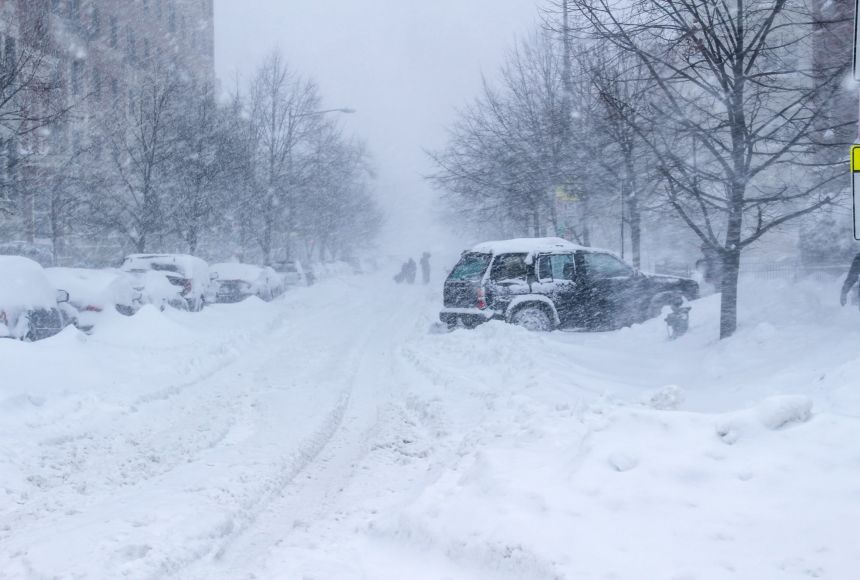In the last decade, unusually severe blizzards have hit the Northeastern United States, making headline news. In February 2010, the U.S. East Coast was hit by a winter storm dubbed "Snowmageddon" or "Snowpocalypse." The storm caused blizzard conditions that brought the Washington, D.C., area to a standstill and broke snowfall records for the mid-Atlantic region. In January 2016, another historic and deadly blizzard, nicknamed "Snowzilla," struck the mid-Atlantic region. In January 2019, a storm that pulled cold low-pressure air from the polar vortex plunged the U.S. Midwest into Arctic conditions.
Scientists predict that extreme weather events like these will become more intense due to climate change. This is despite the fact that winters are getting shorter and global temperatures are on the rise.
A blizzard is a dangerous type of winter storm characterized by strong winds, snow, and reduced visibility. Blizzards form when snow falls in windy conditions or when snow is lifted from the ground by strong winds. Some blizzards can cause whiteout conditions where it is impossible to tell the sky from the ground.
Carbon Dioxide Triggers Global Warming
Between 1991 and 2011, 97 percent of research studies published agree that climate change is real and caused by human activities, like burning of fossil fuels. When fossil fuels such as gas, coal, and oil are burned, large amounts of carbon dioxide (CO₂) are released into the atmosphere. Carbon dioxide is a greenhouse gas that traps heat from the sun in the Earth's atmosphere. Greenhouse gases in appropriate amounts help keep Earth warm enough to support life. However, the addition of human-contributed greenhouse gases to the atmosphere causes global temperatures to rise. This is known as global warming. Average global temperatures have already risen by about 0.8 degrees Celsius (1.4 degrees Fahrenheit) in the last century. Scientists expect temperatures to keep rising if action is not taken to reduce the amount of greenhouse gases in the atmosphere.
Warmer Oceans Help Produce More Severe Storms
Weather and climate are two different things. Weather refers to short-term conditions in the atmosphere in terms of humidity, precipitation, temperature, wind velocity and atmospheric pressure. It could be rainy, sunny, windy or snowing, for example. Climate, on the other hand, is a long-term average of weather patterns. Climate is usually measured over a period of 30 years or more.
A blizzard such as "Snowzilla" is an example of a short-term weather event. On the other hand, the recent warming temperature trends over the past two decades suggest a change in climate.
Scientists predict climate change could make blizzards more intense. A warmer atmosphere holds more moisture. This moisture eventually falls as precipitation, either as rain when temperatures are warm, or snow when temperatures are below freezing. This results in more frequent and intense storms. Sea temperatures are also on the rise, which increases the amount of energy and moisture available to storms, thus increasing their severity.
Winters are getting warmer and shorter, with fewer places experiencing extremely cold temperatures. However, because the warmer atmosphere holds more moisture, blizzards are more likely to occur and be more severe in places where temperatures are still cold enough for snow.
It is difficult to look at a specific storm and say it was caused by climate change. However, scientists are getting closer to doing so with a developing area of research. For example, the "Snowmageddon" blizzards of 2010 have been linked to higher-than-usual surface temperatures in the Atlantic Ocean. Scientists are confident that global warming is making extreme weather events more likely.
Arctic Amplification's Global Effects
Sea ice in the Arctic has been steadily declining. Melting sea ice adds to the effects of global warming in the Arctic. Sunlight usually gets reflected by the ice, but because there is less ice, sunlight gets absorbed by the newly exposed, dark ocean water instead. The sunlight warms the sea surface, which melts more sea ice, and so on. As a result, the Arctic is warming about twice as fast as the rest of the world. It is known as Arctic amplification. This influences weather patterns in other parts of the world.
The effects of global warming are also felt in the atmosphere, particularly the jet stream. The jet stream is a fast-moving current of air that circulates in the lowest region of the atmosphere and has a significant effect on weather in Europe and North America. The bigger the temperature difference in the north and south of its path, the faster the jet stream. As the Arctic warms, the temperature difference between the polar regions and the tropical regions decreases, which slows the jet stream and causes its path to weave farther north and south. As it dips farther south than usual, it pulls Arctic air down from the north, causing a persistent spell of unusually cold weather in that region. Disturbances to the jet stream have been linked to an increase in extreme cold weather events, including blizzards and polar vortex storms.

